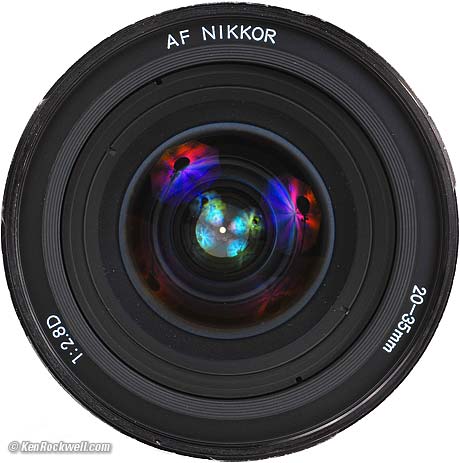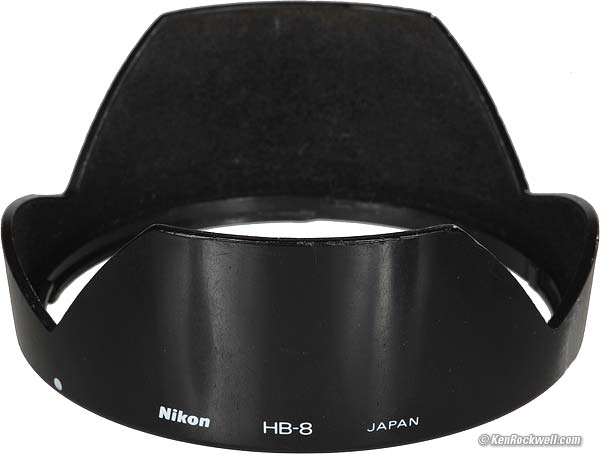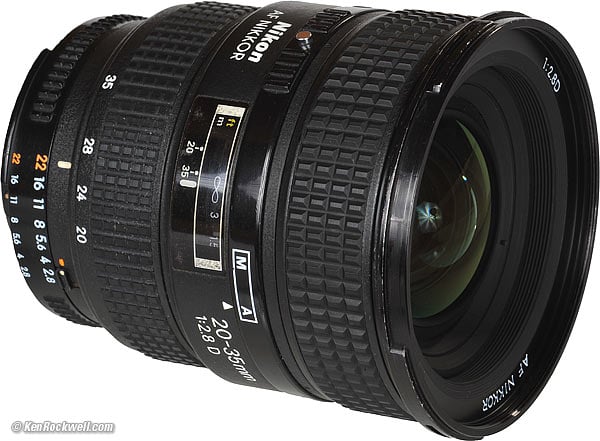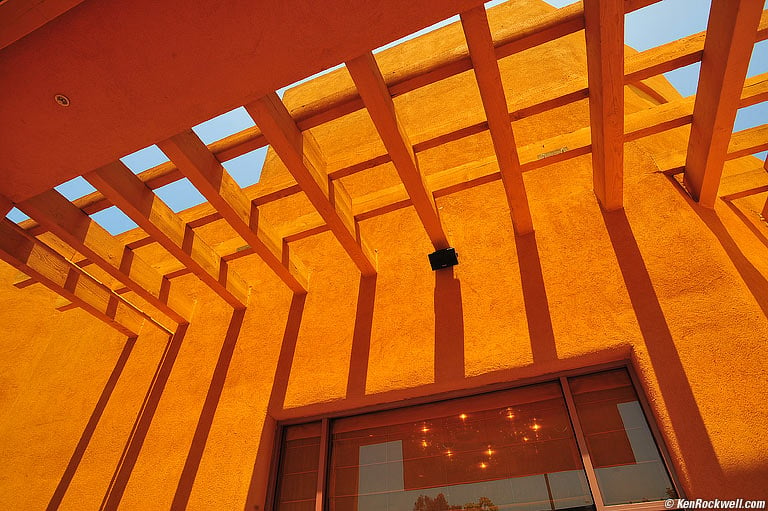Trellis. 20-35mm f/2.8D at 20mm, D3, f/8 at 1/250.
This was Nikon's flagship ultrawide zoom for many years. It works great, and stumbles only if you deliberately try to make it look bad by shooting it wide open in daylight. Distortion is better than newer ultrawide zooms.
Autofocus top
AF speed is fast,
as with most wide angle lenses. One full turn of the AF screw focuses
the lens from infinity to four feet.
It focuses instantly on a D3.
Focus is entirely internal: nothing moves outside the lens.
Manual Focus top
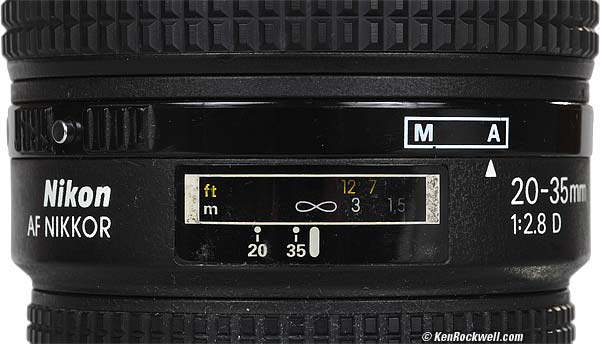
Nikon 20-35mm Focus Stuff.
The 20-35mm requires moving a dorky M - A ring. It's easy: press the button above "Nikon" on the left with your thumb and rotate. It only takes a fraction of a second, but if that fraction of a second misses your shot, you're dead.
Once you've moved the switch, manual focus feels great.
The need for this switch is one of the reasons pro shooters started moving to Canon in the mid-1990s and have never had a reason to return to Nikon, even though Nikon's current pro lenses have fixed this problem. Modern Canon and Nikon lenses need no switch; just grab the ring.
Of course the magic ring of the newer lenses can be a problem when one is trying to hold the lens as steadily as possible, because you can knock the focus ring by accident. On this 20-35mm, the manual focus ring turns but doesn't do anything when in AF mode.
The 20 and 35 markings on the focus scale are infra-red indices.
Zooming top
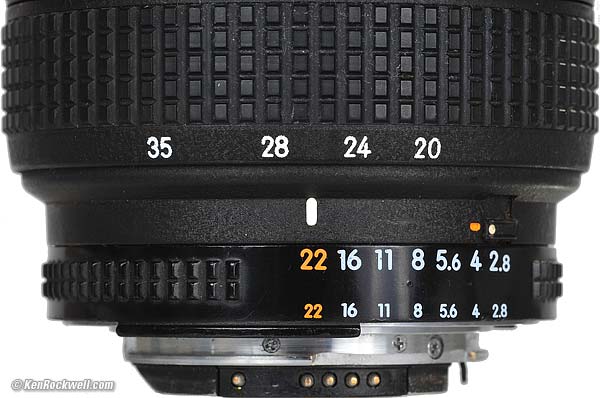
Nikon 20-35mm Zoom Ring.
Zooming is excellent. The narrow zoom range is well spread out on the ring, so it's easy to set an exact framing at any setting. It's easy to zoom with one finger.
The front and rear groups move with zooming, but since they do so inside the barrel, the filter ring never moves.
Sharpness and Light Falloff (corner darkening) top
Used properly, all lenses are sharp. The biggest thing that "better" lenses do is remain sharp when used improperly, like shooting at f/2.8 in daylight.
THe 20-35mm is as sharp as the 17-35mm. Galen Rowell said in the September 1999 issue of "Outdoor Photographer"
that the 20mm f/4 AI manual focus lens was sharper
than this zoom.
On a D3 full-frame FX camera:
At 20mm:
f/2.8: Sharp in center. Very fuzzy in the corners and far sides. This was as good as it got in 1993 wide open at 20mm; it's not a defect. Some falloff (darkening) in corners.
f/4:
Center sharpness even better. Better, but still very soft in corners. Falloff much improved, invisible for real photos.
f/5.6: As sharp as it gets in the center. Still soft in corners. Falloff gone for brick walls.
f/8: Corners usable; falloff completely gone.
f/11: Corners still improving.
f/16: Corners at their sharpest.
f/22: Diffraction softens everything.
At 24mm:
f/2.8: Sharp in center. Very fuzzy in the corners and far sides, but much better than at 20mm. Some falloff (darkening) in corners.
f/4:
Even sharper in center. Better, but still very soft in corners. Falloff much improved, invisible for real photos.
f/5.6: As sharp as it gets in center. Still soft in corners. Falloff is gone.
f/8: Corners usable.
f/11: Corners at their sharpest.
f/16 and
f/22: Diffraction softens everything, worst at f/22.
At 28mm:
f/2.8: Sharp in center. A little hazy in the corners and far sides, but better than at 24mm. Some falloff (darkening) in corners.
f/4:
Even sharper in center. Better, but still soft in corners. Falloff much improved, invisible for real photos.
f/5.6: As sharp as it gets in center. Corners usable. Falloff is gone.
f/8: Corners usable. Falloff is gone.
f/11 and f/16: Corners are at their sharpest.
f/22: Diffraction softens everything.
At 35mm:
f/2.8: Sharp in center. Soft in the corners and far sides. Minor falloff (darkening) in corners.
f/4:
Even sharper in center. Still soft in corners. Falloff much improved, invisible for real photos.
f/5.6: As sharp as it gets in center. Corners usable. Falloff is gone.
f/8: Corners usable. Falloff is gone.
f/11 and f/16: Corners are at their sharpest.
f/22: Diffraction softens everything.
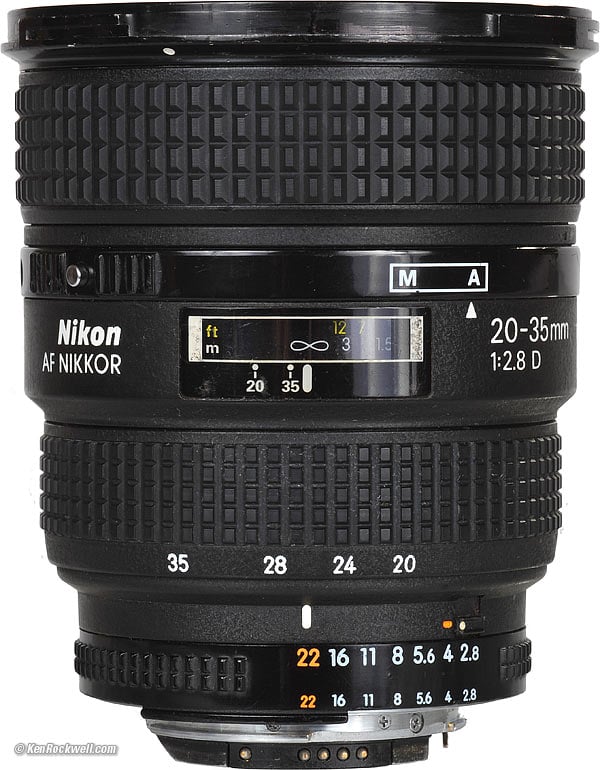
Nikon 20-35mm f/2.8 D. enlarge.
Distortion top
Distortion is better than most zooms. It's minor barrel at the wide end, and almost flat at 35mm. On film and FX digital, it's the least distorting ultrawide zoom I've characterized.
Distortion becomes more barrel at closer distances.
The 20-35mm has a complex (wavy) signature on film and FX, so you'll need a more advanced tool (possibly DxO if they have a module) to correct it fully. On DX digital, it's simpler and therefore easier to correct in Photoshop, but more distorted at the wide end.
Plug these figures into Photoshop CS2's
lens distortion filter to correct the distortion. These aren't facts or specifications, they are the results of my research.
| |
|
|
|
|
20mm |
+3.5* |
+2.0* |
+1.0* |
+2.2 |
24mm |
+1.0* |
+0.2* |
0.0* |
+1.0 |
28mm |
0.0* |
-0.1* |
-1.0* |
+0.5 |
35mm |
-0.5* |
-1.0* |
-1.0* |
0.0 |
© 2007-2010 KenRockwell.com
* a little wavy; never completely corrects with this tool.
Sunstars top
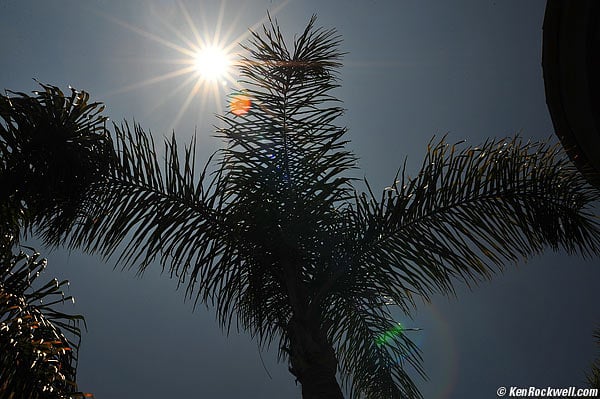
Blind Man's Last Sight. 20-35mm f/2.8 D AF, f/22, -1 stop exposure compensation.
With a straight 9-bladed diaphragm, you'll get 18-pointed sunstars if you push it.
There was a multi-coated filter on the lens for this shot on an FX digital camera at the 35mm setting.
Construction and Materials top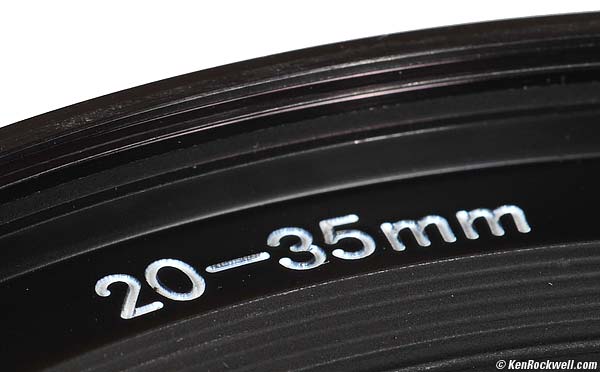
Engraved markings on front ring.
Overall: Lots of metal. Crinkle finish paint.
AF - MF ring: Plastic with metal lock button.
Zoom Ring: Painted metal with rubber grip.
Filter thread and bayonet hood mount: Anodized aluminum.
Front ring markings: Engraved and filled.
Barrel and aperture ring markings: Painted.
Serial number: Laser-burnt into bottom of aperture ring.
Mount: Chromed brass.
Black screw on mount to help when mounting on camera? Yes.
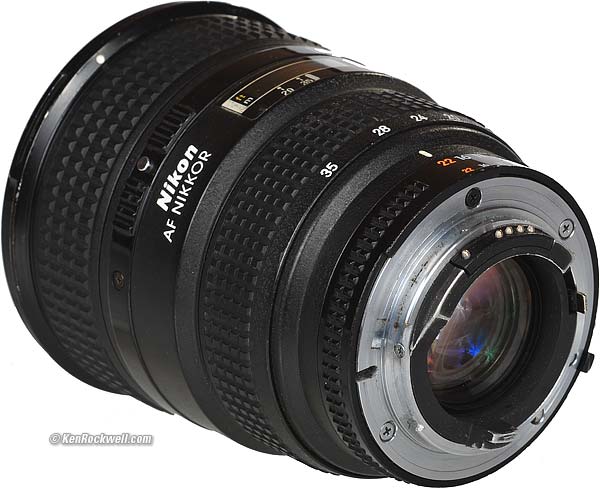
Nikon 20-35mm. enlarge.
Use with Filters top
No problem; even on full-frame, my conventional rotating polarizer or rotating screw-in graduated ND (each 7mm thick excluding threads) work without any vignetting at every aperture and focal length.
If you want to use two of these stacked (14mm thick excluding threads), it works great, but only from 24-35mm. There's vignetting with two stacked fat filters at 20mm at all apertures on film and FX Digital. It's still no problem on DX digital.
The filter ring never moves with either zooming or focusing.
Compared top
Intro Specs Performance Compared Recomendations
See Nikon Ultrawide Zooms Compared.
See Sharpness Comparison to all other 24mm lenses August 2010
See Compared to the Tokina 20-35mm f/3.5-4.5 AF November 2010
Recommendations top
Intro Specs Performance Compared Recomendations
The 17-35mm
f/2.8 AF-S is more
convenient for close and manual focusing, however the 20-35mm is a little
smaller, just as sharp and much less expensive. The results from either are wonderful for most uses,
so if cost is an issue by all means consider the 20-35mm.
Would I use this as my main lens on my D3? No, because the 17-35mm goes wider. Would I take this with my D3 or other FX or film camera when I want something smaller than the 17-35mm
f/2.8 AF-S or more practical for use with filters than the 14-24mm? Absolutely!
Would I recommend the 20-35mm for someone with a $600 budget instead of a $1,500 budget for an ultrawide for film or FX? Absolutely!
Would I use this on DX digital like a D40 or D300? No way; I'd rather use a smaller and more practical DX lens like even the 18-55mm kit lens. FX lenses are bigger and more expensive because they have to cover a larger image area.
Nikon has never made any junk, especially in its professional lenses. If you think you want one of these, go for it.
To save the best news for last, the newer plastic 18-35mm lens is sharper, albeit not by much and with more distortion.
If you want the sharpest possible lens, Nikon's newest 14-24mm is far superior to any other ultrawide zoom on the planet.
Help me help you top
I support my growing family through this website, as crazy as it might seem.
If you find this
as helpful as a book you might have had to buy or a workshop you may
have had to take, feel free to help me continue helping everyone.
If you've gotten your gear through one of my links or helped otherwise, you're family. It's great people like you who allow me to keep adding to this site full-time. Thanks!
If you haven't helped yet, please do, and consider helping me with a gift of $5.00.
The biggest help is when you use any of these links when you get anything. It costs you nothing, and is this site's, and thus my family's, biggest source of support. These places always have the best prices and service, which is why I've used them since before this website existed. I recommend them all personally.
Thanks for reading!
Ken
Home Donate New Search Gallery How-To Books Links Workshops About Contact
|
